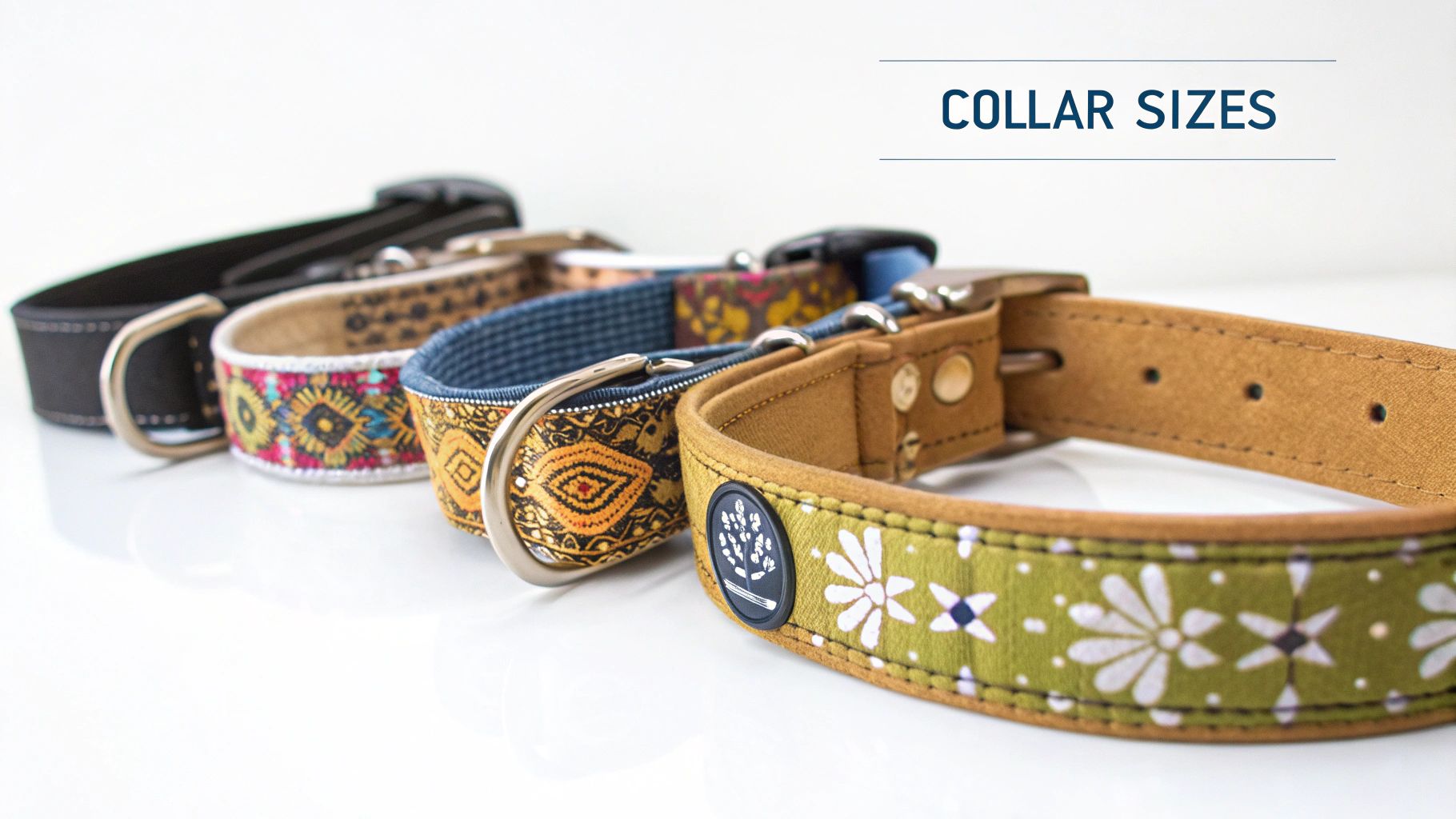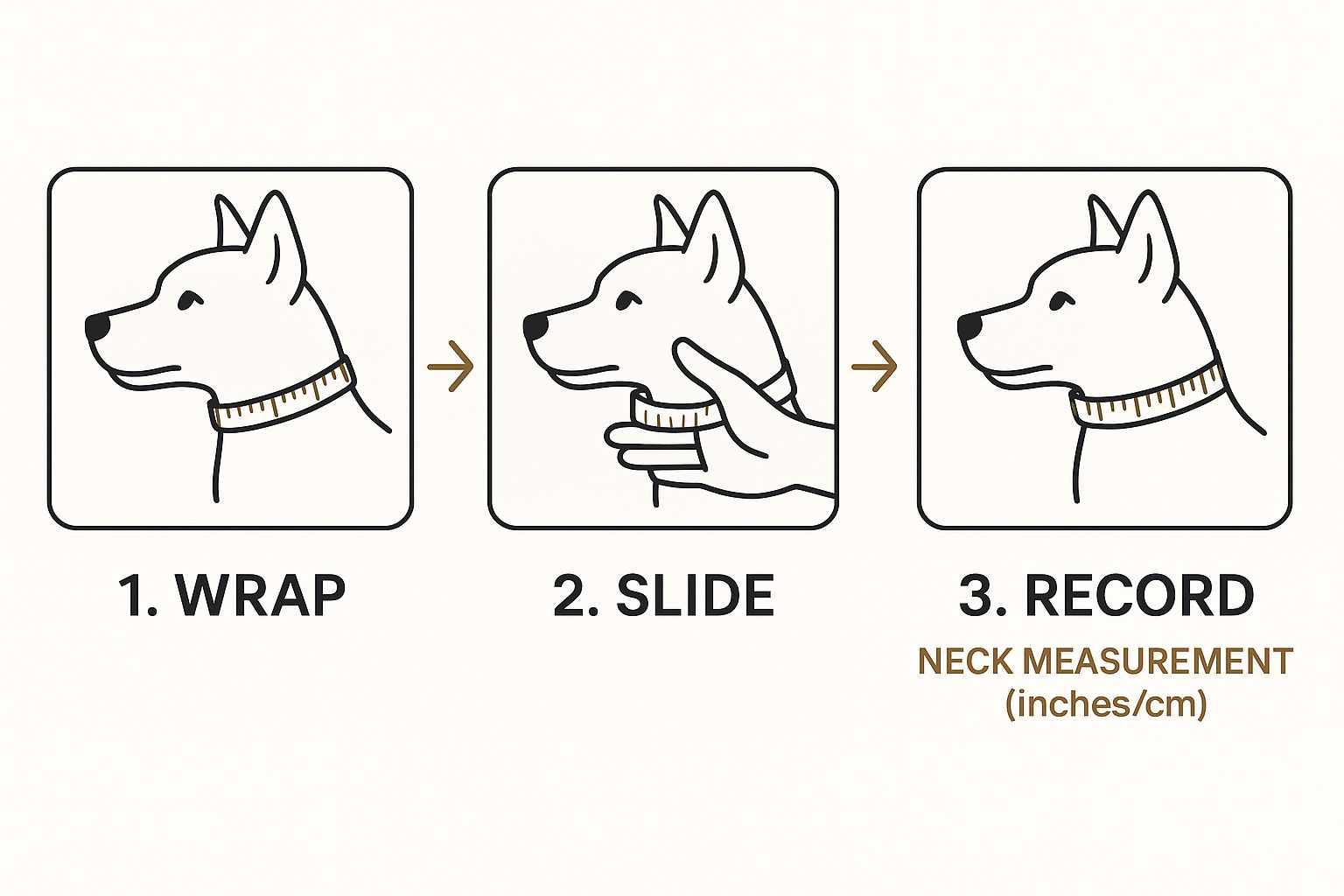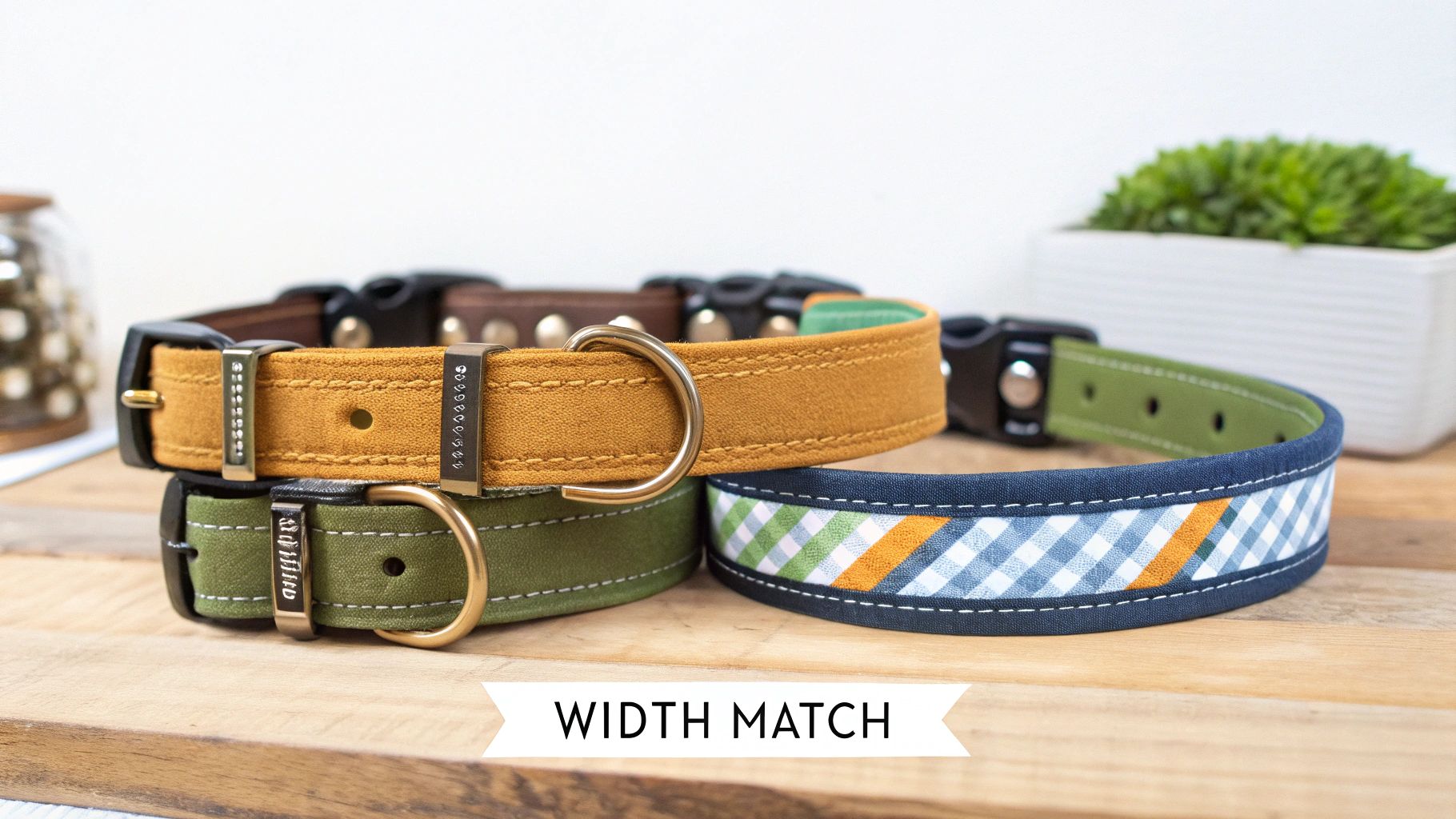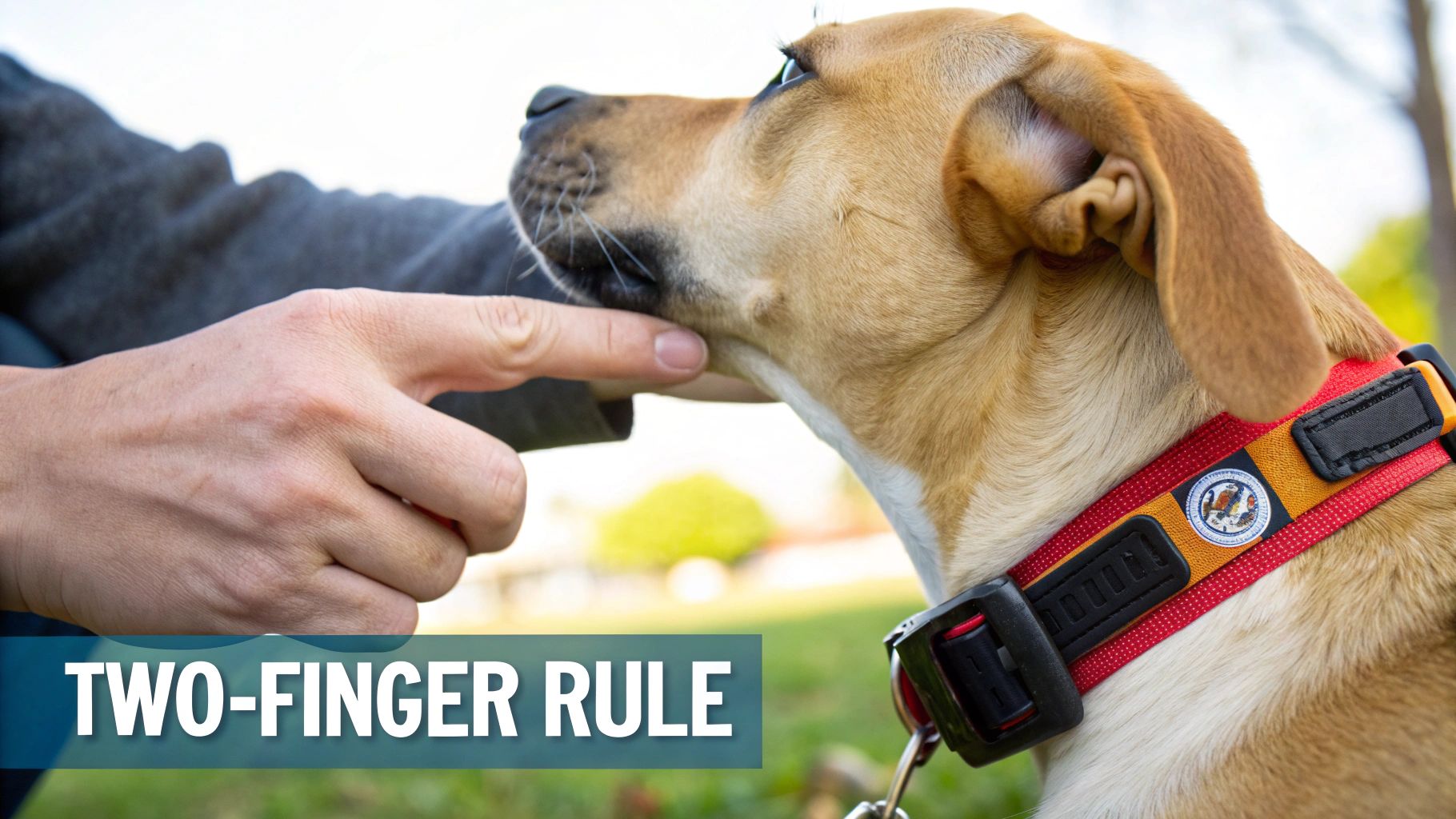Getting the right size dog collar is way easier than you might think. It really just comes down to the classic "two-finger rule."
All you need to do is wrap a soft measuring tape around your dog's neck where their collar would naturally sit. Make sure you can comfortably slip two fingers between the tape and their neck. That simple check is your golden ticket to a collar that isn't dangerously tight or annoyingly loose.
Why a Perfect Fit Matters for Your Dog's Safety

A dog collar is so much more than a place to hang their tags—it’s a direct line to their safety. Nailing the fit is absolutely essential for preventing accidents and keeping your best friend comfortable and secure. An ill-fitting collar, whether too loose or too tight, opens the door to some serious risks that are easy to overlook.
The Dangers of a Loose Collar
When a collar hangs too low, it can easily snag on just about anything—a piece of furniture, a branch on a trail, or even another dog’s tooth during a play session. This can quickly turn into a choking hazard or cause an injury.
Even more common, though, is the escape risk. A sudden loud noise could spook your dog, causing them to panic and slip right out of a loose collar in a split second. It’s a terrifying thought for any owner, and it’s an especially big problem for breeds with slender necks, like Greyhounds.
The Risks of a Tight Collar
On the flip side, a collar that’s cinched down too tight can create a host of health problems. The constant pressure can rub their skin raw, lead to hair loss (a condition called friction alopecia), and cause painful chafing.
A collar that restricts neck movement or presses on the trachea can interfere with breathing and swallowing. Over time, this constant pressure can contribute to neck strain or more severe injuries.
Ultimately, a perfectly fitted collar is a cornerstone of being a responsible dog owner. It gives you security, keeps your dog comfortable, and offers invaluable peace of mind.
Mastering the Two Finger Rule for Collar Fitting
Once you know why a good fit matters so much, learning how to actually size a dog collar is pretty simple. The most reliable method I’ve come across in years of fitting collars is the classic "two-finger rule."
It’s a straightforward technique that takes all the guesswork out of the process, ensuring the collar is snug enough to stay put but has enough give for comfort and safety.
First things first, you'll need a soft, flexible measuring tape. If you don't have one handy, no sweat—a piece of string, a ribbon, or even a phone charging cable works perfectly. Just wrap it around your dog's neck, mark the spot, and then measure the length against a ruler.
Getting an Accurate Neck Measurement
You want to measure around the middle of your dog's neck, right where their collar would naturally sit. If you go too high up by the ears or too low where the neck meets the shoulders, you're going to get an inaccurate reading that throws everything off.
Wrap the tape snugly, but don’t pull it tight. The whole point is to find the perfect fit, and that means leaving a little breathing room.
Now, here's the key: slide two fingers (your index and middle finger work best) flat between the tape and your dog’s neck. If they fit comfortably without you having to force them, you've nailed the measurement. If it's a real struggle to get them in, the collar will be too tight. If there’s a ton of extra space, it’s far too loose.
This infographic breaks down the process visually.

Following these simple steps ensures your measurement lines up perfectly with the two-finger rule, setting you up for a safe and comfortable fit.
One thing I always tell people: don't forget to account for fur! If you have a super fluffy dog like a Samoyed or a Pomeranian, you need to press down gently to get to the actual neck. Otherwise, you’re just measuring a cloud of fur.
To help simplify this, I've put together a quick guide summarizing the best way to get that perfect measurement.
Quick Guide to Measuring Your Dog's Neck
| Tool | Technique | Key Tip |
|---|---|---|
| Soft Measuring Tape | Wrap it around the middle of the neck where the collar sits naturally. | This is the most direct and accurate tool for the job. |
| String or Ribbon | Use it just like a soft tape, mark the length, and then measure against a ruler. | Perfect for when you don't have a flexible tape on hand. |
| The Two-Finger Rule | Slide two fingers between the tape (or collar) and your dog's neck. | This is your final check. It should be snug, but not tight. |
This process ensures you get a number you can trust when you start looking at sizing charts.
This hands-on approach is an industry standard for a reason. The general rule of thumb is to measure the circumference of your dog's neck and then add two inches (about 5 cm) to find the right collar length. So, if your dog’s neck measures 14 inches, you should be looking for a collar in the 16-inch range.
That extra room is exactly what the two-finger rule confirms, giving them space for comfort while preventing them from slipping out. If you're curious about industry trends, you can find more pet product market standards on reports from places like Future Market Insights.
Making Sense of Collar Sizing Charts
Alright, you've got your dog's neck measurement. You're ready to go. But as you start shopping, you’ll quickly notice that one brand's "Medium" is another brand's "Large." Sizing is all over the place in this industry, which is why that number you just measured is your single most important tool.
When you glance at a sizing chart, you'll typically see a range, something like "14-16 inches." If your dog’s neck is a perfect 15 inches, you're golden. But what happens if their measurement is exactly 16 inches? That puts them right on the edge between a Medium (14-16 inches) and a Large (16-18 inches).
What to Do When Your Dog Is Between Sizes
This is a super common situation, and my advice is almost always the same: size up to the Large. Going with the bigger size gives you much more room for adjustment. It ensures you aren't stuck using the very last hole, which puts a lot of unnecessary strain on the buckle and hardware over time. It also gives you a little wiggle room for seasonal coat growth or small weight changes.
The only time I'd hesitate is if sizing up means the collar is suddenly too bulky or heavy. For smaller dogs, a collar that's too wide or has chunky hardware can be really uncomfortable, even if the length is right. Always put their comfort and safety first.
The dog collar market is huge—it hit about USD 5.47 billion globally in 2023, driven by owners wanting both style and function. Yet, even with standard categories like Small (12-16 inches) or Medium (16-20 inches), improper sizing is behind nearly 20% of minor collar-related injuries reported to vets. You can dig into more details on the pet accessories market from Persistence Market Research.
To really see what I mean about the confusion, just look at how different brands might label the exact same neck size.
Typical Sizing Chart Variations by Brand
It's pretty wild how different the labels can be. We put together this quick table to show you why you can't just guess based on your dog's breed or what size they wore last.
| Neck Measurement | Brand A Size | Brand B Size | Brand C Size |
|---|---|---|---|
| 15 inches | Medium | Small | S/M |
| 19 inches | Large | Medium | M/L |
| 23 inches | X-Large | Large | Large |
See? A dog with a 19-inch neck could be a "Large" for Brand A but a "Medium" for Brand B. This table makes it crystal clear why trusting your tape measure is the only way to go. Once you have that solid number, you can shop any brand's chart with total confidence and start exploring all the great styles out there, like the ones in our collection of high-quality dog collars.
Sizing Collars for Puppies and Unique Breeds

Standard sizing advice is a great starting point, but it often doesn't cut it for growing puppies or breeds with unique body types. Let's be honest, a one-size-fits-all approach just won't work when you're dealing with a sighthound or a pup that seems to get bigger overnight.
Take breeds like Greyhounds, Whippets, and other sighthounds, for example. They have these elegant, slender necks that are actually wider at the base than they are at the head. This anatomy makes it dangerously easy for them to back right out of a standard buckle collar. For these little escape artists, a martingale collar is a much safer bet.
Martingale collars have a special design with a smaller loop that tightens gently—never choking—when the dog pulls. This simple feature prevents them from slipping free. When you're fitting one, just slip it over your dog’s head at its largest size, then tighten the main loop until you can comfortably fit two fingers underneath. It’s the same two-finger rule, just with a smarter, safer design.
Sizing for a Growing Puppy
Puppies grow at a truly incredible pace, and their collar needs to keep up. That tiny neck you measured when you brought them home could easily double in size in just a couple of months. The trick here is to find a highly adjustable collar.
Ideally, you want their current neck size to fall at the smallest setting of the collar you buy. This gives you maximum room for growth. You’ll have to stay on top of it, though. I recommend checking the fit at least once a week—that perfect two-finger gap can vanish seemingly overnight.
A common mistake is buying a collar that's way too big, hoping they'll "grow into it." A loose collar on a young, curious puppy is a huge safety hazard. It can easily snag on things or, worse, they could slip out of it and run off.
What About Specialized Smart Collars?
The world of pet tech has thrown another curveball into the sizing game: smart collars. These gadgets offer incredible features like GPS tracking and activity monitoring, but they only work if the fit is absolutely perfect.
Unlike a regular collar, a smart collar needs to be snug enough for its sensors to maintain constant contact with your dog's skin. If it’s too loose, you’ll get glitchy GPS signals or inaccurate health data. The smart collar market, which was valued at around USD 2 billion in 2024, is built on this need for a precise, custom fit. Many brands even offer their own sizing kits to make sure their high-tech health and location monitoring works exactly as intended. If you're interested, you can dig into more details about the growth of the smart pet collar market on Market.us.
Common Sizing Pitfalls (and How to Dodge Them)

Knowing how to wrap a tape measure around your dog’s neck is one thing. But I’ve learned over the years that it’s the little mistakes—the ones that seem so minor at the time—that lead to a collar that’s either uncomfortable or downright unsafe.
Let’s walk through the most common slip-ups I see and how you can easily avoid them.
One of the biggest blunders is measuring the wrong part of the neck entirely. If you measure too high up by the ears, or way too low where the neck meets the shoulders, your numbers are going to be off. You want to measure right where the collar will naturally rest, which is usually smack-dab in the middle of the neck.
Another classic mistake, especially for owners of fluffy breeds like Huskies or Samoyeds, is forgetting about all that glorious fur. Measuring on top of a thick coat can give you a size that becomes dangerously tight right after a trip to the groomer. You have to gently part the fur and make sure your tape is snug against the actual neck.
Don't Trust an Old Collar's Size
It seems so logical, right? Just grab the old collar and buy the same size. But this is probably the most tempting shortcut and a surefire way to get a bad fit. Over time, materials like nylon and leather stretch out, sometimes by a lot.
Plus, just like us, a dog’s neck can change. Weight gain, weight loss, or even just building more muscle can alter their size. Your best bet is to always, always grab a tape measure for a fresh reading before you click "buy now."
A proper fit prevents the two biggest collar-related risks: escape and injury. A collar that’s too loose is a snagging hazard, while one that’s too tight can cause skin irritation and restrict breathing.
While we're on the subject of safety, it's a good idea to also brush up on proper dog harness safety, since different gear is needed for different situations. By sidestepping these common mistakes, you’re doing more than just buying an accessory—you’re making a smart investment in your dog’s everyday well-being.
Your Dog Collar Sizing Questions Answered
Even when you’ve got the right tools and a willing pup, a few questions can pop up when you're trying to nail that perfect collar fit. Let’s tackle some of the most common ones I hear from dog owners so you can feel totally confident in your choice.
How Often Should I Check My Dog's Collar Fit?
It's a great habit to check the fit weekly, especially if you have a rapidly growing puppy or a dog whose weight tends to fluctuate. For adult dogs who have settled into their size, a quick check once a month usually does the trick. Just slide two fingers underneath to make sure nothing has changed.
Keep in mind that a dog's coat changes with the seasons. That collar that fit perfectly in the summer might get a little too snug once their thick winter coat grows in.
My Dog Is Between Two Sizes. Should I Size Up or Down?
Ah, the classic dilemma. In most cases, it’s better to size up, especially if the collar is adjustable. This gives you some wiggle room and ensures you aren't using the very last notch, which can put extra stress on the buckle and hardware over time.
However, there's a catch. If sizing up makes the collar too bulky for your dog or allows it to slip right over their head on the tightest setting, the smaller size is the safer bet. A secure fit should always be your top priority.
Don't just grab an old collar and use its size as a reference. Materials can stretch out, and your dog's neck size can change. Always take a fresh measurement before you buy a new collar to guarantee it’s secure.
Do GPS Attachments Change How a Collar Should Fit?
Yes, they definitely can. For devices that track your dog's location and activity, a snug fit is non-negotiable for getting accurate readings. If you're planning to add one, you’ll probably need a slightly tighter fit than you would with a standard collar.
To make sure you get both safety and function, you can find the perfect GPS dog collar attachment to keep your furry friend safe. A secure collar makes all the difference in ensuring these valuable tools work when you need them most.
At Pet Voyages, we believe every journey with your pet should be a safe one. A well-fitted collar is the first step. Find the perfect travel gear for your next adventure at https://petvoyages.com.

